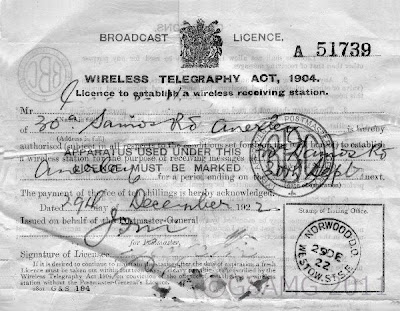.
Digging out some family artifacts, I discovered some interesting photographs of early Wireless equipment
This is marked up as a STIRLING BR1c
it was obviously a top of the range fashionable article.
This one is labled BTH (Probably British Thomson-Houston)
again from the same period (Circa 1925)
An advertising brochure of the time extolled the virtues of the "DE3" electric valve
Examples of all the Wireless's above were seen at the first wireless exhibition.
Note the stand at the far end was a famous capacitor (condenser) manufacturer "DUBILIER"
Still active in 2011
In 1925 the licence to operate wireless equipment in the British Isles cost 10/- (50p) quite a considerable sum at the time, so wireless tended to be an entertainment system for the well-to-do initially.
Amazingly this fee stayed the same right up to 1946 though no licences were issued from 1939 to 1945, the first one to be issued immediately after WW2 was still 10/-
However the 1947 licence was raised to 20/- (1 Pound) and caused quite a howl of protest as at that time the wireless was a key factor in family information and entertainment as it had been throughout the war years.
1922 Wireless licence (10/-)
(I removed the registered name)
Production of Wireless's really got into swing in the post war recovery years with Radio manufacturers that supported the war effort producing communication radios, Radar etc diversifying back to producing an amazing array of different models for the growing domestic market.
Many of these benefited from the technical advances brought about by the war effort, valves produced in their millions could be pressed into use for more mundane domestic receivers, giving superior performance to many used in pre-war wireless equipment.
This was the post war heyday of the Wireless
but television was soon to re-appear and eventually attract many of the wireless listeners over to the
"Moving picture Box"
In most cases (only 1 in 100 homes had TV then)
this usually consisted of a tiny 9" screen (22cm)
some with liquid filled magnifying lenses
to bring the size up to about a foot (30cm).
The first post-war TV receivers were single channel
(45Mc/s) tuned to Alexandra Palace in north London,
later models had extra channels for use in the provincial
City's and towns as the regional TV transmitters
were installed.
The single channel TV receivers used the "TRF" principal
(Tuned Radio Frequency)
Here all the tuned stages were at signal frequency
no conversion as in the more modern receivers.
Valves developed for war-time radar served ideally
for the early TV (Band 1) frequencies, the famous
EF50 a metal encased glass valve being used
in most of the radio frequency stages.
The B9G based EF50 valve
Picture courtesy of "tubecollector"
and here is a Youtube link to EF50
Please note. All the pictures presented here are copyrighted to me and are the property
of my family archive, you may click on them to enlarge them, save them to your own computer
of my family archive, you may click on them to enlarge them, save them to your own computer
device for use but Please if you use them for your own purposes in any publication,
leave me a comment out of courtesy.
If you have a serious archival or reference use in any technical or historical work that
deals with wireless, I can provide on request the full unedited high resolution versions
of the original prints.
deals with wireless, I can provide on request the full unedited high resolution versions
of the original prints.
(You may notice the copyright logo, this is my amateur radio callsign)






No comments:
Post a Comment